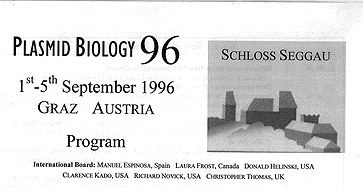Plasmid pGT5 from the archaeon Pyrococcus abyssi :
Evidences for Rolling Circle Replication
in a Hyperthermophile
Stéphanie Marsin, Yvan Zivanovic, Nadia Benbouzid-Rollet, Daniel Prieur* and Patrick Forterre.
Institut de génétique et Microbiologie, Université Paris-Sud, 91405 Orsay Cedex, France.
*Station Biologique CNRS BP 74 29682 Roscoff Cedex, France
Nothing is known about DNA replication in archaea, the third domain of life. In Bacteria and Eucarya, plasmids and other small genetic elements have been essential to decipher molecular systems involved in DNA replication. Plasmids are also essential to design vectors and other genetic tools which are presently missing in hyperthermophilic archaea. Hyperthermophiles have attracted much attention recently because of their biotechnological potential and their strategic position in early life evolution (1). We have recently isolated the first plasmid detected in a hyperthermophile, pGT5 (3.4 kb) from the archaeon Pyrococcus abyssi (2). This organism, which has been isolated from a deep sea hydrothermal vent, grows in anaerobic conditions between 67*C and 102* with an optimum at 96*C.
Sequence analysis of the plasmid pGT5 has revealed that it could replicate via the rolling-circle (RC) mechanism and belongs to the family of RC plasmid pC194 (3). The major ORF of pGT5 encodes a polypeptide showing similarities with the protein Rep of these plasmids. Putative single-stranded origin (sso) and double-stranded origin (dso) were detected upstream of the Rep ORF. The dso corresponds to 11 nucleotides identical to the dso of pC194 (around the nick site) whilst the sso exhibits similarities with the DnaG E.coli primase recognition site. Hence, in marker contrast to known RC bacterial plasmids, pGT5 replication seems to be primosome dependent (similarly to that of phiX174).
Plasmid RC replication sometimes generates a small amount of single-stranded intermediate (ssDNA) that can be detected in crude extracts of host cells. We have thus looked for pGT5 ssDNA in P. abyssi . A few preparations displayed a pGT5 ssDNA that hybridized specifically with the plus strand of pGT5 and not with the minus strand (3). These results indicated that pGT5 actually replicates by a rolling circle mechanism.
We also checked the activity of the pGT5 putative sso in E. coli and in B. subtilis . In both cases, we did not see any conversion activity from the single stranded DNA to the double stranded DNA in these hosts. We also obtained negative results when we looked for the activity of pGT5 Rep in E. coli and in B. subtilis .
The gene encoding Rep was then cloned in a vector to be overexpressed in E. coli . We obtained a protein overproduced with the correct size on SDS page acrylamide gel, and which represents about 30% of cell proteins. This protein is not soluble in E. coli , being recovered in the inclusion bodies. Currently, we are trying to solubilise and renature this protein, and to look for DNA relaxation activity at 95*C. Our future project is to set up an archaeal in vitro hyperthermophile replication system based on pGT5.
1) Forterre, P.
A hot topic: the origin of hyperthermophiles.
Cell, 85, 789-792
2) Erauso, G., Charbonnier, F., Barbeyron, T., Forterre, P. Et D. Prieur, D.
Preliminary characterization of an ultrathermophilic archaebacterium with a plasmid isolated from North Fiji basin hydrothermal vent.
C. R. Acad. Sci., Paris, 314, 387-393 (1992)
3) Erauso, G., Marsin, S., Benbouzid-Rollet, N., Baucher, M.F.,Barbeyron, T., Zivanovic, Y., Prieur, D. and Forterre, P.
Sequence of plasmid pGT5 from the archaeon Pyrococcus abyssi: Evidence for rolling-circle replication in a hyperthermophile.
J. Bacteriol. , 178, 3232-3237 (1996)
|
















